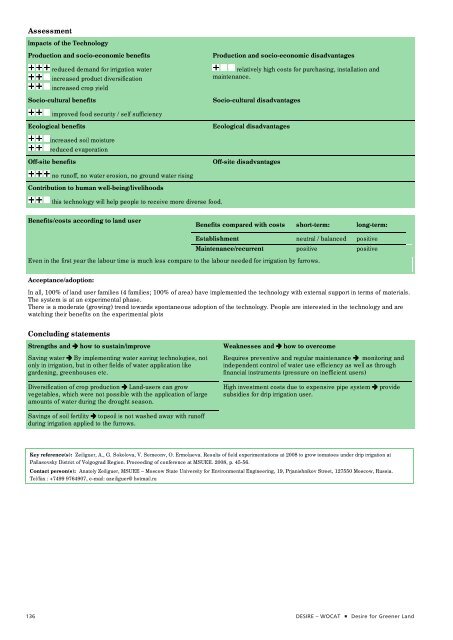Desire for Greener Land
Desire for Greener Land
Desire for Greener Land
You also want an ePaper? Increase the reach of your titles
YUMPU automatically turns print PDFs into web optimized ePapers that Google loves.
Assessment<br />
Impacts of the Technology<br />
Production and socio-economic benefits Production and socio-economic disadvantages<br />
reduced demand <strong>for</strong> irrigation water<br />
increased product diversification<br />
increased crop yield<br />
relatively high costs <strong>for</strong> purchasing, installation and<br />
maintenance.<br />
Socio-cultural benefits Socio-cultural disadvantages<br />
improved food security / self sufficiency<br />
Ecological benefits Ecological disadvantages<br />
increased soil moisture<br />
reduced evaporation<br />
Off-site benefits Off-site disadvantages<br />
no runoff, no water erosion, no ground water rising<br />
Contribution to human well-being/livelihoods<br />
this technology will help people to receive more diverse food.<br />
Benefits/costs according to land user<br />
Benefits compared with costs short-term: long-term:<br />
Establishment neutral / balanced positive<br />
Maintenance/recurrent positive positive<br />
Even in the first year the labour time is much less compare to the labour needed <strong>for</strong> irrigation by furrows.<br />
Acceptance/adoption:<br />
In all, 100% of land user families (4 families; 100% of area) have implemented the technology with external support in terms of materials.<br />
The system is at an experimental phase.<br />
There is a moderate (growing) trend towards spontaneous adoption of the technology. People are interested in the technology and are<br />
watching their benefits on the experimental plots<br />
Concluding statements<br />
Strengths and how to sustain/improve Weaknesses and how to overcome<br />
Saving water By implementing water saving technologies, not<br />
only in irrigation, but in other fields of water application like<br />
gardening, greenhouses etc.<br />
Diversification of crop production <strong>Land</strong>-users can grow<br />
vegetables, which were not possible with the application of large<br />
amounts of water during the drought season.<br />
Savings of soil fertility topsoil is not washed away with runoff<br />
during irrigation applied to the furrows.<br />
Requires preventive and regular maintenance monitoring and<br />
independent control of water use efficiency as well as through<br />
financial instruments (pressure on inefficient users)<br />
High investment costs due to expensive pipe system provide<br />
subsidies <strong>for</strong> drip irrigation user.<br />
Key reference(s): Zeiliguer, A., G. Sokolova, V. Semeonv, O. Ermolaeva. Results of field experimentations at 2008 to grow tomatoes under drip irrigation at<br />
Pallasovsky District of Volgograd Region. Proceeding of conference at MSUEE. 2008, p. 45-56.<br />
Contact person(s): Anatoly Zeiliguer, MSUEE – Moscow State University <strong>for</strong> Environmental Engineering, 19, Prjanishnikov Street, 127550 Moscow, Russia.<br />
Tel/fax : +7499 9764907, e-mail: azeiliguer@hotmail.ru<br />
136 DESIRE – WOCAT <strong>Desire</strong> <strong>for</strong> <strong>Greener</strong> <strong>Land</strong>









